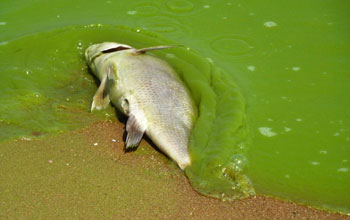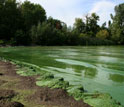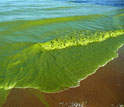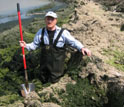News Release 13-057
Extreme Algae Blooms: The New Normal?
Record-breaking bloom in Lake Erie triggered by 'perfect storm' of events

Fish suffocated in the Lake Erie algae bloom of August 2011, near Pelee Island, Ontario.
April 1, 2013
This material is available primarily for archival purposes. Telephone numbers or other contact information may be out of date; please see current contact information at media contacts.
The following is part four in a series on the National Science Foundation's Water, Sustainability and Climate (WSC) Program. Parts one, two, three and five in this series are available on the NSF website.
A 2011 record-breaking algae bloom in Lake Erie was triggered by long-term agricultural practices coupled with extreme precipitation, followed by weak lake circulation and warm temperatures, scientists have discovered.
The researchers also predict that, unless agricultural policies change, the lake will continue to experience extreme blooms.
"The factors that led to this explosion of algal blooms are all related to humans and our interaction with the environment," says Bruce Hamilton, program director at the National Science Foundation (NSF), which funded the research through its Water, Sustainability and Climate (WSC) Program.
WSC is part of NSF's Science, Engineering and Education for Sustainability (SEES) initiative.
"Population growth, changes in agricultural practices and climate change are all part of the equation," says Hamilton. "These findings show us where we need to focus our attention in the future."
Results of the research are published in this week's online early edition of the journal Proceedings of the National Academy of Sciences (PNAS).
"The 'perfect storm' of weather events and agricultural practices that occurred in 2011 is unfortunately consistent with ongoing trends," says Anna Michalak, the paper's lead author and a scientist at the Carnegie Institution for Science's Department of Global Ecology, located at Stanford University.
"That means that more huge algal blooms can be expected in the future, unless a scientifically-guided management plan is implemented for the region."
Freshwater algal blooms may result when high amounts of phosphorus and nitrogen are added to the water, usually as runoff from fertilizer.
These excess nutrients encourage unusual growth of algae and aquatic plants.
When the plants and algae die, decomposers in the water that feed on them use up oxygen, which can drop to levels too low for aquatic life to thrive.
At first the Lake Erie algae were almost entirely Microcystis, an organism that produces a liver toxin and can cause skin irritation.
The scientists combined sampling and satellite-based observations of the lake with computer simulations to track the bloom.
It began in the lake's Western region in mid-July and covered an area of 230 square miles.
At its peak in October, the bloom had expanded to more than 1,930 square miles. Its peak intensity was more than three times greater than any other bloom on record.
The researchers looked at numerous factors that could have contributed to the bloom, including land-use, agricultural practices, runoff, wind, temperature, precipitation and circulation.
They found that three agriculture management practices in the area can lead to increased nutrient runoff: autumn fertilization, broadcast fertilization (uniform distribution of fertilizer over the whole cropped field), and reduced tillage.
These practices have increased in the region over the last decade.
Conditions in the fall of 2010 were ideal for harvesting and preparing fields and increasing fertilizer application for spring planting.
A series of strong storms the following spring caused large amounts of phosphorus to flow into the lake.
In May alone rainfall was more than 6.5 inches, a level more than 75 percent above the prior 20-year average for the month.
This onslaught resulted in one of the largest spring phosphorus loads since 1975, when intensive monitoring began.
Lake Erie was not unusually calm and warm before the bloom. But after the bloom began, warmer water and weaker currents encouraged a more productive bloom than in prior years.
The longer period of weak circulation and warmer temperatures helped incubate the bloom and allowed the Microcystis to remain near the top of the water column. That had the added effect of preventing the nutrients from being flushed out of the system.
The researchers' data did not support the idea that land-use and crop choices contributed to the increase in nutrient run-off that fueled the bloom.
To determine the likelihood of future mega-blooms, the scientists analyzed climate model simulations under both past and future climate conditions.
They found that severe storms become more likely in the future, with a 50 percent increase in the frequency of precipitation events of .80 inch or more of rain.
Stronger storms, with greater than 1.2 inch of rain, could be twice as frequent.
The researchers believe that future calm conditions with weak lake circulation after a bloom's onset are also likely to continue, since current trends show decreasing wind speeds across the United States.
That would result in longer-lasting blooms and decreased mixing in the water column.
"Although future strong storms may be part of the new normal," says Michalak, "better management practices could be implemented to provide some relief to the problem."
The research was also supported by the NOAA Center for Sponsored Coastal Ocean Research and the Lake Erie Protection Fund.
-NSF-
-
Lake Erie algae bloom in September 2011, covering the lake's entire western basin.
Credit and Larger Version -
Cup of fouled water, scooped from Lake Erie during the algae bloom.
Credit and Larger Version -
The 2011 Lake Erie algae bloom resulted from record-breaking nutrient loads.
Credit and Larger Version -
Algae wash ashore in waves on Lake Erie's southeastern shore.
Credit and Larger Version -
Researcher amid an algae accumulation along Lake Erie's southwestern shoreline.
Credit and Larger Version
Media Contacts
Cheryl Dybas, NSF, (703) 292-7734, email: cdybas@nsf.gov
Tina McDowell, Carnegie Institution for Science, (202) 939-1120, email: tmcdowell@carnegiescience.edu
Related Websites
How Is Earth's Water System Linked With Land Use, Climate Change and Ecosystems?: http://www.nsf.gov/news/news_summ.jsp?cntn_id=125434&org=NSF&from=news
NSF Awards Grants for Study of Water Sustainability and Climate: http://www.nsf.gov/news/news_summ.jsp?cntn_id=117819
Science, Engineering and Education for Sustainability NSF-Wide Investment (SEES): http://www.nsf.gov/sees/
NSF "Discoveries in Sustainability" Publication: http://www.nsf.gov/pubs/2012/disco12001/disco12001.pdf
The U.S. National Science Foundation propels the nation forward by advancing fundamental research in all fields of science and engineering. NSF supports research and people by providing facilities, instruments and funding to support their ingenuity and sustain the U.S. as a global leader in research and innovation. With a fiscal year 2023 budget of $9.5 billion, NSF funds reach all 50 states through grants to nearly 2,000 colleges, universities and institutions. Each year, NSF receives more than 40,000 competitive proposals and makes about 11,000 new awards. Those awards include support for cooperative research with industry, Arctic and Antarctic research and operations, and U.S. participation in international scientific efforts.
Connect with us online
NSF website: nsf.gov
NSF News: nsf.gov/news
For News Media: nsf.gov/news/newsroom
Statistics: nsf.gov/statistics/
Awards database: nsf.gov/awardsearch/
Follow us on social
Twitter: twitter.com/NSF
Facebook: facebook.com/US.NSF
Instagram: instagram.com/nsfgov





